#i need. good cards for the flora titan.
Explore tagged Tumblr posts
Text
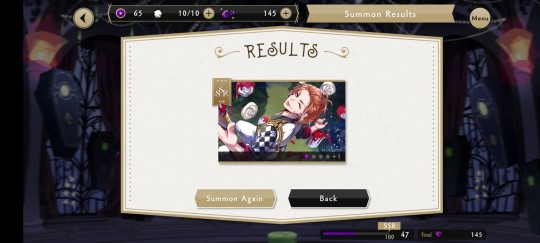
ARE YOU FUCKING KIDDING ME.
#im. trying to beat book 6 chapter 67.#i need. good cards for the flora titan.#TWISTED WONDERLAND.#CAN YOU STOP GIVING ME USELESS CARDS THAT I CAN USE PLEASE.#WHAT THE FUCK.#I DON'T EVEN LIKE CATER WHY WOULD YOU DO THIS TO ME.#FUCK.#disney twisted wonderland#twisted wonderland#twst
4 notes
·
View notes
Text
Writing Notes: Sweet Child O' Mine: Scarytales ETC
Last chapter there was a Grimwalker Scarytale and a little more background about Osran's family.
I was super nervous about writing this chapter for a few reasons.
First, I am a huge fan of mythology, folklore, fairytales etc. I wasn't sure it would work, or if I could get the feel of it down in universe.
Second, people seemed into the idea and I felt a lot of pressure, but folks seemed into it!
For more info, the text of the scarytale, and the identity of the character who gave the "gift" in the flashback from Hunter and Willow's engagement party below.
For reference: In a previous chapter it was suggested that the "Grimwalker" books currently available (those Hunter read while hiding out at Hexside etc. were ripe with half truths, misinterpretations or just bad information all together. In fairytales, we often can get an idea of how folks saw various populations through the way they are regarded in story.
So, for the scarytale, it didn't have to be clear if this was an edit or the original version. It gives a general sense as to how grimwalkers had been portrayed on the Boiling Isles. It was not good. There's also a nod to how basilisks might have been seen as well.
Lilith also lets Hunter and Willow know, in addition to Osran being from an influential family (one he connects with the oracle in the scarytale) he had a distant relative in the castle that spied for him and likely tipped him off that Hunter was a grimwalker.
The only other character who has "fingers" on their head.
In the flashback where Hunter and Willow receive the "gift" of a decapitated snake on their engagement party, there is a card with a message written in blood. And that message is:
"Regards, Kikimora."
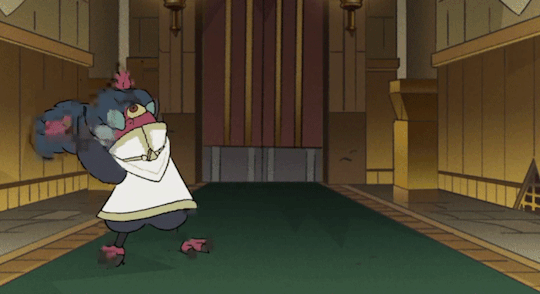
LEGENDS OF GRIMWALKERS
Fifth Edition Stories Collected and Edited by Head Witch G’Mork with Foreword by Flora D’Splora.
TALE IX
Oracle of Lovoed
Once two witch brothers traveled through a forest. They were returning from a war and looking to make their fortune on the Boiling Isles. The older brother was tall and handsome and beloved by all the witches and demons who set eyes upon him. The younger brother was serious and stern, but what he lacked in charm, he made up for in shrewdness.
The brothers followed a strange path to a clearing where they happened upon a castle surrounded by cobblestone streets.
Oracles by trade, the brothers set up shop and were immediately approached by royal guards and brought to the castle for a feast with the King and his two children.
The prince was attractive and jovial. He had an affinity for potion magic and dazzled the elder brother with tales of his deeds. The princess was an appealing young witch, but her sullen expression soured the meal. Her half lidded eyes turned away from her father and his guests, while dozens of blood red roses bloomed in her hair. She had plucked one from her long black braid, and held it to her nose as if drinking in its scent, while she cradled its stem in her delicate fingers.
After the meal, the King dismissed his children and turned to the brothers.
“What do you think of the prince and princess?” The King asked.
“The prince is lovely” Blushed the elder brother dreamily.
“And my daughter?” Asked the king quite seriously. “I expect honesty.” He added, giving a pointed look towards the younger brother.
”She would be comelier, if her expression was cheerier.” answered the younger.
The King nodded. “I would like your help. We are in need of an Oracle and none of the witches or demons in my fiefdom are known for such magic. It seems that my daughter is under an enchantment. Every night she goes to bed, at a sound hour, but in the morning she emerges from her quarters exhausted. Her slippers are covered in dirt, and her hair is a nest of those Titan-damned flowers.”
The younger son drew a spell circle as his eyes fell into a vision. He Saw the young princess in a locked garden in embrace with a mysterious figure with eyes that glowed eyes as red as the roses in her hair. When he told the king what he saw, his majesty’s mood became volatile.
“It was as I have suspected!!” He shouted. “The princess has been seduced by a grimwalker.”
The brothers had heard of such monsters, with their intense eyes and their penchant for trickery, created as replacements for the dead.
“For too long I have permitted noble families to keep these creatures as servants in substitution for their children who had perished in service to the Kingdom – but no more.”
That night the King ordered all the grimwalkers in the kingdom be drawn out to the courtyard and slaughtered, their galdorstone hearts added to the treasury. The brothers were lauded as heroes and the princess was sent to bed hoping that to be the end of the matter.
But the next morning the princess once again emerged from her room, walking in a daze, her slippers covered in dirt and her hair a tangle of roses.
“Your vision has failed!” The king told the young Oracle. “I will give you two more chances to prove your skills. And as insurance I will lock your brother in the dungeon!”
Once again, the Oracle looked into the eyes of the princess and he Saw another vision of the same sinister figure, this time it held the princess an intimate embrace, the creature’s eyes bled with lust as it placed its lips upon hers.
When the King heard what had been Seen, he fumed and demanded all families who had kept these creatures’s properties seized until the monster with a hold on his daughter was captured. That night the King ordered guards to stand outside the princess’s door and window.
But the guards were foolish and took tea from the princess that had been enchanted with sleeping nettles. In the morning the princess emerged from her quarters once more, shoes even dirtier, eyes heavier, thorny roses in her hair.
Now the King was furious. He threw the guards out to die in the boiling rain where they melted away. He turned to the young Oracle. “This is your last chance! Find out how to release my daughter from this enchantment or you and your brother will suffer the same fate as the guards!”
The Oracle looked into the eyes of the princess once more. Now not only did he See this creature, its eyes glowing bright, its breath upon her neck. But now he Heard them making plans to escape together. But he could not See the path to the location of their tryst.
“Sire, if I may.” Said the younger brother. “I have a plan to entrap this creature, I require a potion of wakefulness, a small band of your finest soldiers and a basilisk skin cloak.
“I will give you what you ask for, but your failure will seal your doom.”
As an extra precaution, The king ordered the princess’s windows bricked shut. This time the young Oracle himself sat guard. The princess wished him goodnight and offered him a tea blend which he knew was enchanted. The Oracle drank it for show and immediately as the door closed he drank the potion of wakefulness.
At the stroke of midnight the princess emerged from her room, moving in stilted motions, as if under a mind control spell. The Oracle pretended to sleep as she slipped past and when he was in the clear, altered the King’s soldiers to follow him quietly. The Oracle trailed the princess to an old walled garden as she drew three spell circles summoning vines from all around. She scaled the vines and when she had made it over, the Oracle and guards did the same.
The Oracle ordered the guards to trap the princess and demanded she that call for her lover. She screamed and with the basilisk skin cloak, the Oracle shifted into the form of the princess. When the grimwalker arrived to claim its prize, the guards captured it, casting a netting spell over its writhing form.
The Oracle proudly presented the monster to the King as it spewed lies of affection for the princess and false grief for the loss of its kin. Its eyes leaked and when that did no good, it lunched forward, gnashing its terrible teeth, taking ten guards to restrain its monstrous form.
As guards prepared the grimwalker for execution as the princess begged for its life, so deep into its spell that she had lost all dignity.
“Do not be fooled, pet.” The King soothed her. “This creature feels no love. It mimics life. Everything it says is a trick.”
“You have done well”, he told the young Oracle. “As a reward, your brother will marry my son the prince and inherit half of my kingdom. And you will have my daughter’s hand in marriage.”
But the young Oracle was not satisfied.
“Your daughter has no claim to the crown. No power. She has consorted with a monster. And my brother will become a ruler? I did all the work! ”
The King shook his head. “You do not have the bearing of a King, but you are cunning enough to challenge me. What is it you want?”
The Oracle lifted his chin and spoke the words that rested deep within his belly.
“I want influence! I want wealth! I want to be the most powerful Oracle that ever lived!”
The King considered this.
“Then I offer you a place as my advisor, an estate with many servants, ten galdorstones, and this grimwalker’s body.”
“I do not need a monster as a servant, let alone one that will betray me and make off with my wife!” The Oracle scoffed, already imagining his wedding night with the princess.
“ I will tell you a secret.” said the King , “Drain dry the blood from this creature and keep a vial of it’s life force around your neck. With its magic, your visions will surpass any oracles that have come before. You and your descendants will See beyond any witches that have come before. You gain influence, wealth and prosper in all the realms for as long as the magic is potent.”
And with that, the Oracle ran a sword straight the heart of the creature. As it bled out, its body returned to wood and stone. The princess let out a harrowing shriek thus freeing the her enchantment.
The Oracle married her and they lived ever after.
Footnotes:
To this day, It is thought to this day that the blood of a Grimwalker is especially valuable to oracles, enhancing their visions, and increasing their power tenfold. This story is attributed as the origin of that belief.
#toh fanfic#hunter noceda#willow park#a03 fanfic#toh hunter#fanfiction#huntlow#sweet child o mine#toh osran#grimwalker lore#grimwalkers#toh grimwalker#fanfic analysis
10 notes
·
View notes
Text
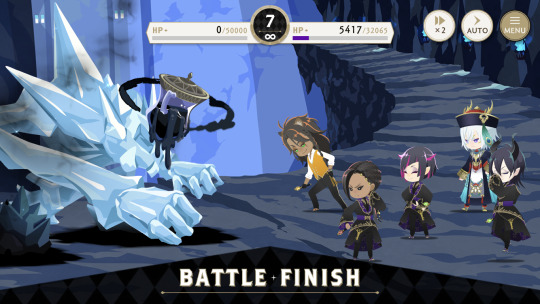
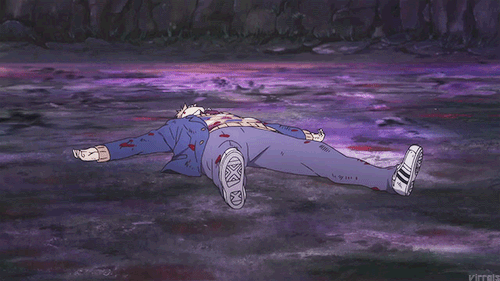
Episode 6 spoilers below!
Where do I even fucking begin?😭
I’m a sobbing mess right now. The last part came out May 20th, so it’s been two months already. Two freaking months trying desperately to move past chapters 66 and 67. Yes, I am pathetic and absolutely suck as a gamer. I never imagined twst devs were gonna challenge me like this. This is what I get for never taking a video game seriously, but I told myself “This is the hill I will die on. This is my grave to dig.” For two fucking months, I’ve done nothing but non-stop grinding, non-stop farming, spending all of my madol, tokens, notepads, notebooks, grimoires, honeys, and so on to level up so many cards.

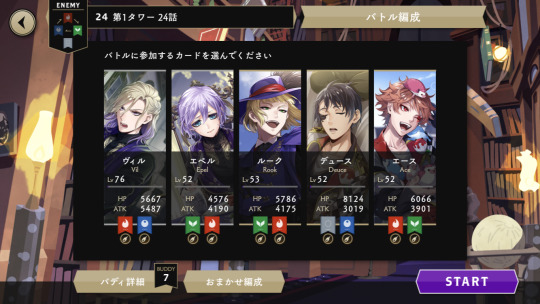
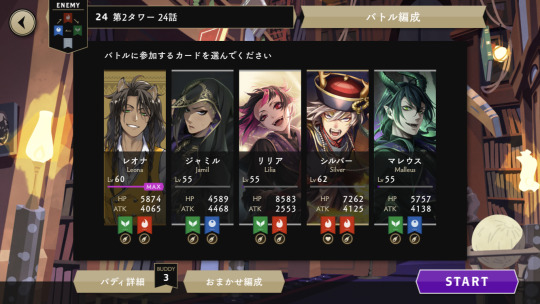

As I mentioned before, I made a small change in line-up when I got to chapter 67 by adding Idia. The Riddle/Azul team did not require much attention when I did this. But, what was the Pomefiore team and Leona/Jamil… It was absolutely taxing.
If this serves as help to anyone, make sure you have SSRs that can duo magic. Get those magic levels to lv5 at least. Have someone in your party that can heal. Obviously, have some decent cards that work well against the titans. Like, I never imagined my SR Vil card to pack so much attack with his water magic. I’m honestly really surprised. Oh, make sure all your cards are groovied too. And, of course, study the way the titans attack and do your best to counter every one of their moves. I did miss once or twice, but I at least tried to be 100% accurate with the predictions. Otherwise, I’d restart the battle and try again.
That said, I didn’t struggle at all taking on OB!Idia (and Ortho). Idia’s overblot design had already been spoiled for me, but to finally see it for myself including Ortho was still a surprise. I wasn’t really sure what to expect, but with my trusty SSR Dorm Riddle card, all I needed was a friend’s SSR Dorm Azul to duo magic with. With Azul’s healing, and the double duo magic between the two, countering Idia’s fire and flora attacks was super easy! And, again, I brought Vil’s ceremonial robes card to add that much needed back-up☺️ Lab Jade and GM Idia were there as little reinforcements. Really, I breezed through all three overblot battles.✨
And now, for a fucking round of applause. VIL SCHOENHEIT, GUYS!!!👏👏👏
All this Vil slander as of late…ABSOLUTELY NOT! DO NOT SLEEP ON THE POMEFIORE TRIO!!!!!
ROOK, EPEL, AND VIL STOLE THE FUCKING SHOW!! THEY ABSOLUTELY SAVED THE WORLD! VIL EVEN SACRIFICED HIMSELF!!!
Honestly, they were just introducing themselves in Book 5. Book 6 is where they truly shine!💖 And, I know I said it before jokingly, but seriously… They took in Yuu, and without hesitation made them one of their own. How they went out of their way to make sure Yuu was okay and safe, risking their very lives to protect them at any given moment, and just looking after their well being. Yes, the Pometrio absolutely became Yuu’s newfound family. I already had a feeling Vil was gonna let Yuu and Grim stay in Pomefiore while the renovations at Ramshackle were underway. I wish we’d gotten to see a bit of that, tbh. I’m just loving this new budding friendship/family.
To me, more than any other previous dorm, I feel like Pomefiore really stepped up to the plate and showed exactly why they are not just the oldest dorm in NRC, but why they are damn good at what they do. Vil’s leadership as housewarden went above and beyond, and he absolutely deserves to be at the top. Epel finally gaining his unique magic and developing in his own means while still leaving room for growth has me feeling so proud. And Rook, my sweet, precious Rook❤️ His support, his faith, and guidance, I’m thankful to him. To all of them.
Of course, Riddle, Leona, Azul, and Jamil are right there next to them. They may have all been “problematic children” as Idia calls them, but they definitely pulled their own weight. Even if they mostly spent it squabbling amongst each other. I’m relieved and happy they worked through their differences, and were able to pull through. Absolutely loved Azul’s back story, and Leona giving Jamil some much needed advice.
Now, for Idia and Ortho… Oh my god… First of all, I loved the world building and the Shroud lore. All the Hercules references were an absolute treat! However, Idia and Ortho…oof! I fucking cried. Ugly cried. Their story… The heartache, the sadness, clawed and broke my heart into pieces. I did not imagine such tragedy. Even the truth behind Ortho… I’m still blown away. Ortho is an absolute gem. He’s another character like Vil who slowly grew on me. And when I buy for Idia, I decided I couldn’t have him without Ortho. I love Ortho a lot more now. If only he’d come home to me already😭 And Idia…I don’t think a hug is enough to give. His grief impaled me deep in my soul. They were so innocent, merely wanting to see the outside world… Like Vil said, they have their dreams just like anyone else. But, of course, destroying the world is not an option😆 My love for the Shroud brothers deepened a lot more, though. They are so cute and precious. Protect them at all costs!🥲
That said, wow…. A group of teenagers put themselves in danger to stop the world from getting destroyed. If we’re gonna slander anyone, Crowley absolutely deserves it. Of course, there would be nothing incriminating him. Of course, he’d accept hush money from Idia’s parents and STYX HQ. I guess the only good thing to come out of this is Ortho’s new status and Idia now more willing to be friends even if he still needs a bit of encouragement and pushing.
I’m really looking forward to Book 7 now. However long it takes me, I know I can do it. And, I’ve got my eyes on Malleus. Oh, he was so sweet checking up on Yuu and making sure they weren’t hurt. But, I have a feeling this was a sign. Especially with Malleus seriously contemplating the fragility of humans now. Please, let me be right. I wouldn’t mind if Malleus kidnapped Yuu😭 Because I totally wanna be rescued by Idia😂💙
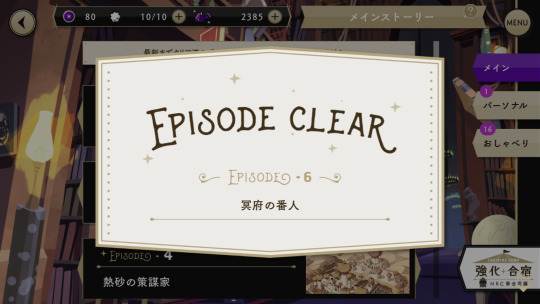
Let me recover my resources now😭😭😭😭😭😭😭
#twisted wonderland#disney twst#twst spoilers#episode 6#long post#toreii chit chat#im done im done😭#よかった😩
7 notes
·
View notes
Text
Eldritch Moon my beloved
I think most Magic players are going to have a favourite set. Often that’s going to be one they started playing with, or one that really got them into the game, or one that had a limited or standard format they really enjoyed. A lot of people won’t, and that’s okay, they’re allowed, it’s hard to pick favourites sometimes.
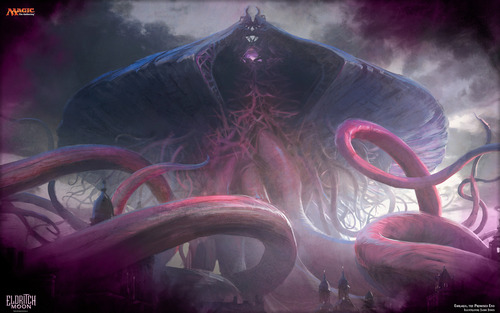
But for me, it’s Eldritch Moon, aka the last time we went to Innistrad, and things got a bit more tentacular.
Eldritch Moon had a lot working against it from the get-go.

The Shadows block immediately followed the Battle for Zendikar block, one which a lot of people Didn’t Like. Whether it be for some of the more questionable art direction, for the relatively weak cards and boring parasitic mechanics, and for arguably some of the lamest story the game has had to date. More relevantly, though, it was a pair of sets where a fan-favourite plane was essentially dominated by squid monsters and lost a lot of its unique identity in the process- gone was the fun D&D-esque adventure world, replaced by stark wastelands and a war story with like one good story article. It’s the Tazri one.
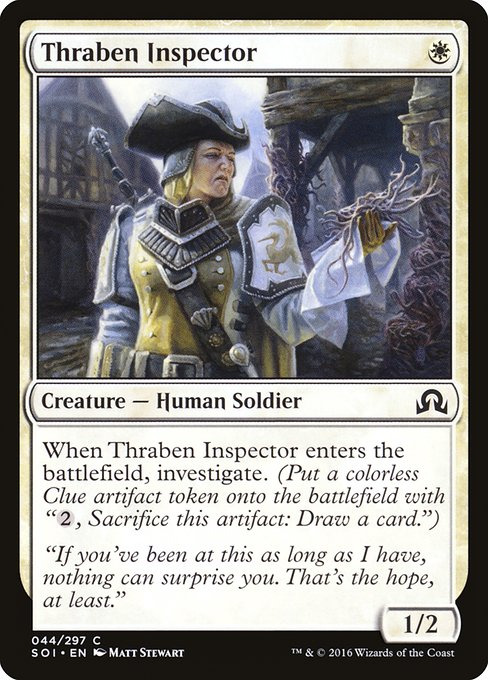
And then the next set was Shadows over Innistrad. Another return to a fan-favourite plane, with a huge mystery being built up as to why everything was going to shit again. Why Avacyn and her angels were turning on humanity, why there are all these funky stones everywhere, what exactly Nahiri was doing fucking around on the plane of someone she apparently doesn’t like very much.
There were cryptic hints in the set itself. Its title is a reference to the Lovecraft story, Shadows over Innsmouth, with a fair few cards alluding to the story itself. A few cards did have subtle tentacles in the art, as well as subtle warping of flesh and world. The most damning clue came in the form of a puzzle regarding different flavour texts for the card Tamiyo’s Journal, which gave a particular phrase- “Remember this: they came as three”- flavour text from a Battle for Zendikar card referring to the three Eldrazi Titans, only two of which had been dealt with in that story.
Despite this, people still denied that this was the plot-to-be. There were still rumours that it was somehow Marit Lage again after all this time, or that the threat was a new one, or that it was somehow the Gitrog Monster’s fault. Personally, I wanted to believe this, and desperately didn’t want the next set to be Eldrazi-themed- I’d gotten pretty sick of them from BfZ and OGW and was very much enjoying all the new Werewolves and Madness cards and Delirium mechanic. This was at the point where I was drafting at FNM weekly, and the fun differential between the two blocks was stark.
But of course, the mystery was revealed. It was old god Emrakul the whoooole time! Quelle fucking surprise. And yet it ended up being significantly better than the previous block, for a number of reasons.

Firstly, the story is just kind of better. We get to see distinctly through the cards and the plot how the influence of Emrakul has affected the regular citizens of Innistrad, and how all its various factions- the Church, the vampire manors, the packs of werewolves, et cetera- were all twisted in her visage. We get to see the desperate fight against them, with all these gothic horrors warring against eldritch horrors, and against themselves. And we get both Jace doing some surreal journey-to-the-centre-of-the-mind shit while Liliana gets to be the hero and Tamiyo gives us an ending that raises more questions than it answers.
Also, Sorin gets stuck in a rock. Fuck that guy, Nahiri was always cooler, and fuck War of the Spark for apparently just having them make up off screen.
Secondly, the cards. Flavourwise, the three Eldrazi Titans’ corrupting influence manifests differently for each- Ulamog consumes and drains the world, Kozilek corrupts the mind and wreaks havoc on space, and Emrakul? As we see, Emrakul twists flesh into new and horrifying shapes, that the set’s cards display in loving and disgusting detail. While Ulamog and Kozilek’s drones were clearly a part of themselves, the Eldrazi of Innistrad all used to be something much more reasonable before Emrakul made it to the plane.

There are three types of Eldrazi in this set. Firstly- the transform mechanic from Innistrads previous has been played with to suit the needs of the flavour. With the exception of Ulrich, every single double-faced card represents a creature from the world, be it Human or Werewolf or otherwise, that is touched by Emrakul and makes a permanent transformation into something else. There’re masses of limbs, shapes echoing Emrakul herself, and flesh in configurations that Should Not Be. The shift on every card is stark, and in every case, you have to actively put in effort to push them over the edge- and off a cliff which they cannot come back from. This is especially true with the Meld mechanic, with the cards fusing into this giant monstrosity that literally dwarfs every other card on the table.
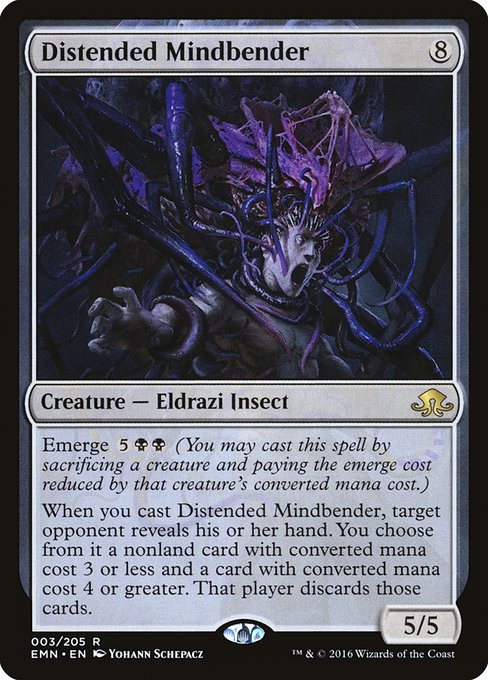
The next type of EMN-drazi is the Emerge creatures. The mechanic was extremely fun, almost all the cards were eminently playable in at least one format (mostly just limited), and the art is spooky. The flavour of some guy on your table getting fucking chestbursted and having fucking Elder Deep-Fiend pop out is incredible, and each is a great way of showing how the regular fauna of the plane (and flora, like, I think Lashweed Lurker is a plant or something) are mutating in response to the creature’s presence.

Finally, there’s the cards that make 3/2 Eldrazi Horror tokens. There’s less of these and they’re less intense, but by and large they’re a representation of the regular people being affected by the whole thing. Just about every card that makes one of these involves a creature dying in some way (Desperate Sentry, Otherworldly Outburst) or being spawned by an existing mass of flesh (Hanweir, Howling Chorus), and it gives this sense that everybody is affected by this effect.
Of course, that was also a thing in Battle for Zendikar block. The whole thing was Eldrazi, Eldrazi, Eldrazi, with even vanilla 4/3 worms having something to say about fighting them. They key difference of Eldritch Moon is that the flavour of the world is still preserved outside of this Eldrazi presence.
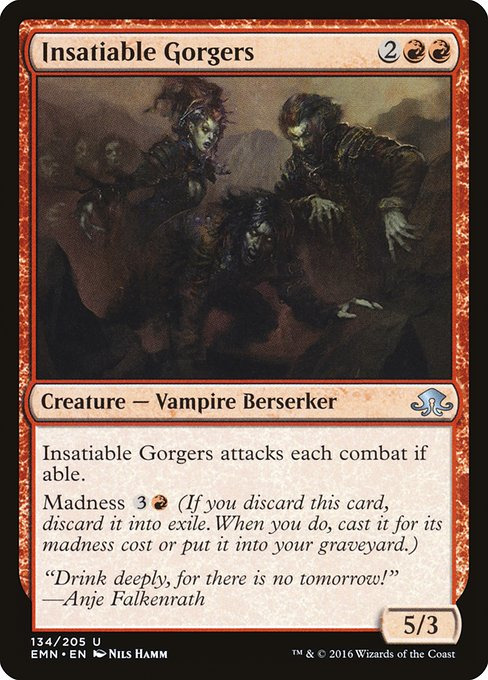
What I’m saying is- the gothic horror of Innistrad is still present despite the eldritch horror of the set’s antagonist. There’s still a corrupt and violent church (albeit with a few more tentacles now), there are still cults and Frankenstein zombies and vampires and werewolves. Innistrad’s tone is compatible enough with the Eldrazi’s that the combination enhances the two rather than diminishes them.
The final thing I want to say is just- the set’s really fun. It has a bunch of my favourite classic limited cards- Thermo-Alchemist, Ulvenwald Captive, and Boon of Emrakul- along with multi-format all-stars like Grim Flayer and Collective Brutality. It has big potential get-there moments with the Meld cards and some of the flip Eldrazi, and splashy interesting cards like Emrakul herself and Harmless Offering. The set drips with flavour that enhances the gameplay, with very little wasted space.

It’s a set I only really have two complaints about. Firstly- lol Ulrich isn’t good and wasn’t what basically any werewolf fan was after. And two- it suffers from an eternal issue that Magic only recently solved, in that it’s a Small Set with a pile of mechanics that it cannot possibly fully explore in its 200 or so cards. The biggest victim of this is Meld, as they could only fit 3 pairs in under the restraints of the set size. And that’s a real shame, considering that it’s a mechanic that we’re probably never seeing again, especially considering the recent Midnight Hunt. I really think there was a missed opportunity to not have a few leftover Eldrazi in that set- whatever happened to the Dronepack? Or the corrupted vampire houses? I suppose, though, that “I want more!” can be the best complaint a creator can get.
Eldritch Moon had big shoes to fill. However, in my eyes, it didn’t just fill those shoes. It filled them and kept filling them until its distended toes burst out the front and sides of the shoes and just kept growing, and bending in really weird ways, and I think I’ve lost the plot of this metaphor. It’s my favourite Magic set, and I don’t see that changing for a while.
#ramble#mtg#mtgemn#eldritch moon#this was the first storyline where jace actually got to be interesting
10 notes
·
View notes
Text
Fantasia at 34
A review by Adam D. Jaspering
By 1940, Disney proved he was as large a titan in the world of feature films as he was in animated shorts. But as the saying goes, a man's reach should exceed his grasp. His third feature, Fantasia, would be an audacious experiment.
Disney had been synchronizing animated cartoons to classical music since 1928. His trademarked Silly Symphony shorts earned him seven Academy Awards. They were a foundational element of the Disney empire, but they were outmoded by 1939. Audiences were preferring plot-driven shorts.
Coincidentally, another Disney creation was also in decline in this era. It’s hard to fathom, but Mickey Mouse’s popularity with audiences peaked in 1935. By 1939, he was eclipsed by both Donald Duck and Goofy. More frequently, Mickey appeared alongside the two than appearing in his own independent shorts.
Disney had plans to bring both musical shorts and Mickey Mouse back into the limelight. Disney employed the assistance of The Philadelphia Orchestra and conductor Leopold Stokowsky. The Sorcerer's Apprentice was completed in 1938, pairing Mickey Mouse with the music of Paul Dukas in a nine-minute cinematic epic.
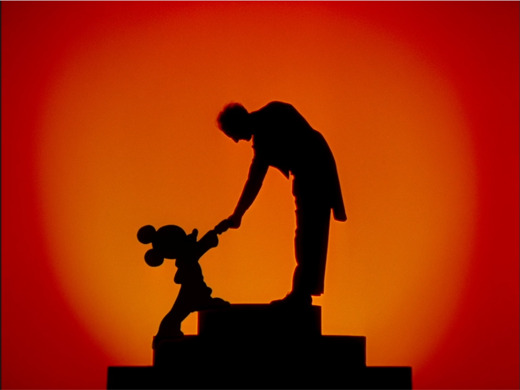
However, Walt Disney’s brother Roy, accountant for the company, crunched the numbers. The $125,000 budget made the short a logistical nightmare. To make a profit, the short needed to be released as a feature film. And to be a feature film, it needed to be feature length.
The Concert Feature, as it was initially called, grew in size and scale. The budget grew to $2.8 million. The crew ballooned to over one thousand artists and animators. After much effort and many headaches, Fantasia was finally released in November, 1940.
The film starts with a heavily stylized depiction of the orchestra and their instruments. The background is blue and vibrant, but every musician is ensconced in shadow. Lights from the music stands illuminate a negligible part or their personage. We can see the musicians, but only just.

From the onset, the film accomplishes two goals: First, it wants you to understand you are seeing live-action people. Mickey Mouse is on all the posters. Disney’s name is attached to the film. But these are real, non-animated people. Quite possibly the first live-action people filmed by Walt Disney since his Alice shorts.
Second, Fantasia wants you to realize you are seeing real people, but they are not the focus. The attention is not on them, but their instruments. This is a film not about people, but sound and music.
This is furthered as the sounds of Bach’s Toccata and Fugue in D Minor begins. The silhouettes of the musicians are projected onto the backdrop, scaled larger than their sources. The musicians become literal giants. The shadows create a form of puppetry, becoming indistinguishable from animation. Fantasy and reality, sound and imagery have become intertwined. It’s difficult to determine when the cameras stop rolling, and the ink and paints take over.

We are informed from the outset that Fantasia’s visuals are not those of trained musicians or scholars. These images are the thoughts and feelings of animators and artists. We are privy to new interpretations of classic works (well, new to 1940), beginning with Toccata and Fugue.
Defined as “Absolute Music,” Toccata and Fugue is an instantly recognizable piece of classical music. It is the go-to stock music whenever a movie, TV show or cartoon wants to quickly and unmistakably associate a scene with a sense of foreboding doom. But Fantasia undoes this eternally mired association; the booming bass offers no semblance of the intimidating or macabre.
Emcee Deems Taylor warns outright we’ll be experiencing non-representative form and abstract imagery. If the impressionist movement coexisted with film, it would probably resemble something like this. In a way, it’s almost a warning for impatient and fickle audiences. Doubly so, as it leads the procession of animated shorts. It’s a fair warning: This is experimental film. Your mileage may vary.

The abstraction gives way to the first representative piece. Tchaikovsky’s Nutcracker Suite; perhaps the most widely known ballet in modern society. We get a great demonstration about the longevity and shifting legacy of classical works as Taylor informs us “nobody performs it nowadays.” Art does not belong to an era, it belongs to the ages. I’m 34, and I’ve never known a Christmas where The Nutcracker wasn’t being performed somewhere in the city.
The Nutcracker Suite depicts the various flora and fauna of an enchanted forest, all engaged in a unique and stylized dance suited to their physique. What’s more, each movement is indicative to a nation and culture. We see Russian flowers, Arabian fish, French blossoms, and Chinese mushrooms (questionably stylized Chinese mushrooms. Thank you, 1940s).

As problematic as the mushrooms are, I’m more perplexed by the Arabian fish. Obviously the sequence is an allusion to the eroticized stereotype of middle eastern women, particularly the Dance of Seven Veils and other subsequent belly dance numbers.
It’s a very g-rated version of the burlesque staple, but one has to wonder why it exists at all. At some point in the late 1930s/early 1940s, someone designed a fish to look and act like a belly dancer. Those eyes exist only for the purpose of portraying a sense of eroticism. Not to kinkshame somebody on Tumblr, but it’s very clear somebody on Disney’s staff was working through some things.

Each of these dances feature plants and animals evocative in style and movement of their corresponding dance’s nationality. This implies the animators were indeed versed on the background of Tchaikovsky’s Nutcracker Suite and his original intent. This breaks the promise from the start of the film: interpretations of artists, not of scholars.
It’s not an invalidating breach, and not total (surely Tchaikovsky never intended Clara and the prince to meet an amorous fish). But if Fantasia deliberately specified itself to not utilize scholarly interpretations. They waffled on this promise, and it should be noted.
Dukas’s The Sorcerer’s Apprentice is an interesting specimen. Not only has Mickey Mouse’s cautionary tale of a proper work ethic completely eclipsed its musical source in popular culture, but the short has eclipsed the entirety of Fantasia.
When one hears the word “Fantasia,” one’s mind immediately leaps to Mickey Mouse in a bathrobe. They think of the blue hat, festooned with stars. They think of an army of brooms, brought to life, obediently and endlessly carrying buckets of water. They think of the bassoons secondarily. Most are unaware the music existed before the movie.

That said, there is no better representation of Fantasia’s central tenet: a marriage of animation as an artistic medium and classical music as an eternal font of inspiration. In The Sorcerer’s Apprentice, not a word of dialogue is spoken and not a single intertitle is used. An idea is formed, expressed and delivered by the movement onscreen, buoyed by the themes and mood of the orchestral score. What results is a tale beloved for generations.
Stravinsky’s The Rite of Spring offers a brief history of prehistoric life. We see the cosmos create planet Earth. Tectonic plates shift and form land. Life is formed, evolving from single celled organisms, progressing up the evolutionary ladder. But this truncated history of eons and eons comprises only half the segment. The remainder is a grandiose depiction of life in the nadir of the Mesozoic Era. Dinosaurs in all their titanic glory.
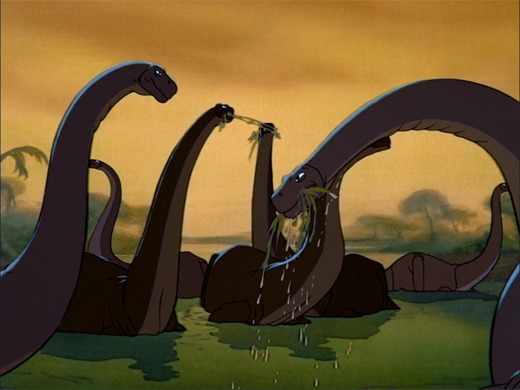
Every few years, an animation company attempts to create a dinosaur-centered film. Either through lack of confidence or executive meddling, these dinosaurs aren’t allowed to simply be dinosaurs. We don’t see the glory of the creatures or the power struggle between herbivore and carnivore. Instead, these dinosaurs speak. They learn lessons and have character arcs. They’re often used as a parable of teamwork and community, or an allegorical tale of standing up to one’s oppressors.
Disney themselves fell into that trap in the year 2000, but we’ll address that soon enough. Dinosaurs are mesmerizing in their own right, as the animals they were. They require no personification. They need no story and no character. A musical short may be the closest we’ll ever get to such a film. For now, we can still enjoy the sight of a tyrannosaur fighting a stegosaurus to the death.
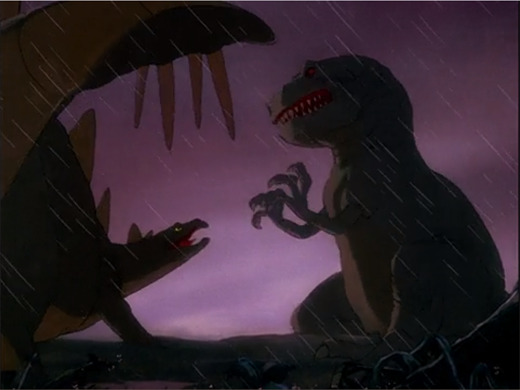
An interesting element of Fantasia, a remnant of a bygone era, is the intermission. When Taylor announced the film would break for a 15 minute intermission, I was concerned as the orchestra began slowly shuffling out of the amphitheater. Was the movie really going to stop? Fantasia is already fighting an uphill battle, trying to keep audiences with temperamental patience captivated. Stopping all inertia for fifteen minutes is suicidal.
Many films from the first half of film history, especially those longer than three hours, survive in their current forms with an intermission built in. Their home release is presented exactly as their theatrical release. The score’s overture plays over a meticulously designed title card, encouraging theater-goers to stretch their legs and visit the lobby. These intermissions have been preserved for posterity, but are wholly inconsequential with fast forward buttons and chapter select options.
I was concerned such would be the case for Fantasia, which barely crests the two-hour mark. It’s the longest of all Disney’s animated features, but surely that record is not because of a deliberate 15-minute time out? If persnickety audience of the 1940s needed a break, what of children in the digital age? They would minimize the window and never return.
Fantasia’s title card is present, but immediately returns back to the film, all for the better. It’s a pointless detour maintained for an illusion of legacy and integrity. Fantasia’s musical numbers are all well and good in their own right, but the live-action segments with the orchestra is full of questionable moments like these.
For example, at one point, a percussionist interrupts Deems Taylor by knocking over his bells. There’s no build up to this, no explanation, and no commentary. It happens, and is promptly forgotten. If it’s a joke, it makes no sense. If it’s a mistake, why was it left in?

Perhaps Disney had no idea how to carry these live segments. He was afraid to let the segments speak for themselves, feeling obligated to inject them with more than a curated introduction. He needed to pepper in little moments that would either change the dynamic or mandate attention.
These moments rob the gravitas delivered by the orchestra, interrupt the flow of the picture, and make the audience wait impatiently for the next segment. Disney Studios would experiment with live-action film over the next decade, but these missteps display exactly why Disney Studios was not ready for a fully live-action film until the 1950s.
Beethoven’s Pastoral Symphony is not the strangest segment of the film, but it becomes more surreal the more it’s examined. Early on, after a brief dance with satyrs, unicorns, and pegasi, we’re greeted with a number of topless, bathing centaurettes. One wouldn’t think Disney would brazenly depict frontal nudity, but there we are. Fully nude cherubs further the dissonance.

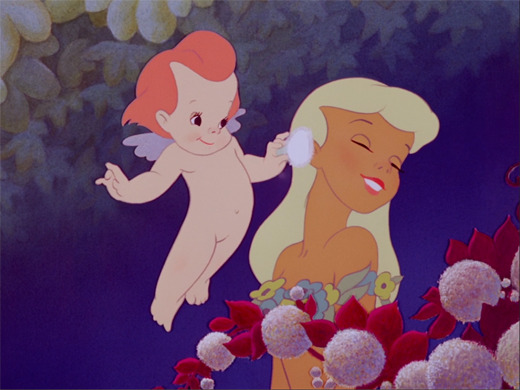
Greek and Roman mythology contains stories of heroes, legends, monsters, and adventure. It’s also rife with depictions of incest, rape, violence, and general malfeasance. Adapting any tale concerning the Olympians requires great skill, lest it be so thematically vulgar, it’s outright rejected by modern sensibilities. Even moreso when the tale is to be presented in a G-rated setting. As obvious a statement this may seem, it’s odd for Fantasia to have an entire segment dedicated to the Roman deity Bacchus and his trademark love of wine.

To say the wine flows is an understatement. A golden chalice overflows with some of the most tantalizing violet liquid ever depicted on film.I don’t even like wine, but I would take up a glass if it was offered.
Bacchus merrily sways back and forth in a drunken stupor for his entire appearance. Caught in a mixture of revelry and lightheadedness, the inebriated god is the central figure of a literal bacchanal. Fantasia was released the same year as Pinocchio, which depicted drunkards in such a negative light, they were turned into donkeys. Bacchus rides a unicorn-donkey who enjoys the taste of wine as much as his master. Behold: The duality of Disney.
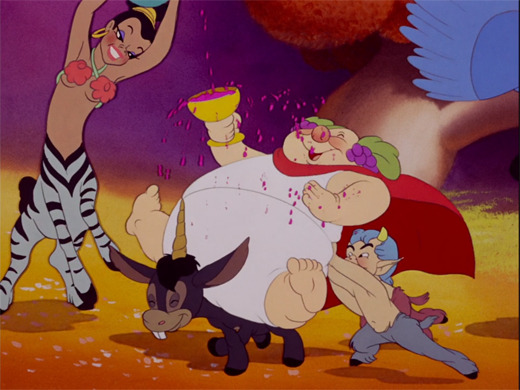
Ponchielli’s Dance of the Hours is perhaps the second most famous segment to come from Fantasia. The premise behind the segment is simple. Ballerinas are renowned for their lithe bodies and graceful elegance. What if, instead of traditional ballerinas, they were depicted by animals? Animals renowned for their girth, gangling physique, or stumpy limbs? It’s the contrast that provides comedy. Whatever age, whatever era, it will always be funny watching a hippopotamus do ballet.

As such, Fantasia gives us the sight of ostriches, elephants, alligators, and hippopotamuses, dressed in traditional tutus and slippers, dancing to the best of their ability. To the animator’s credit, the disparate physiques of the animals are hardly an issue. The absurd sizes and shapes of the animals bend and flex in a comical, but equally elegant manner.
The final segment is a combination of Mussorgsky’s A Night on Bald Mountain and Schubert’s Ave Maria. Here, the devil presides over Walpurgis Night, welcoming ghouls, ghosts, and witches alike from the realm of the damned into the world of the living. They are then conquered, banished back from whence they came, by the choir of a mere church processional.
For the longest time, I’ve heard the central figure of this piece referred to as “Chernobog,” a central figure of Russian and Balkan folklore. Much like Honest John in Pinocchio, this naming must be supplemental or subsequently; he is never referred to as Chernobog in the film. He is simply referred to by Taylor as “Satan.”
So far in Fantasia, we’ve been exposed to murder, alcoholism, nudity, and sexy fish. Having the Prince of Darkness make an appearance is the final taboo that Walt Disney could break. Perhaps this is why the name Chernobog was attached retroactively. Pious Americans couldn’t abide a depiction of the devil in an animated feature.

All in all, I prefer the idea of the horned figure being a literal depiction of Satan over Chernobog. Primarily, it makes much more sense thematically. Why would a Russian myth be toppled by a Christian hymn? He wouldn’t, unless it was some misguided attempt at an analogy of Christianity versus Paganism. But why make an analogy when the literal interpretation is exactly appropriate?
Possibly, western righteousness defeating a Russian emblem could be interpreted as a Cold War fable. This is rather unlikely, as the Cold War didn’t start in earnest until years after Fantasia’s release.
Second, if we interpret the character as the devil, it further serves the story Disney’s animators were trying to tell: one of good versus evil. Darkness versus light. Chaos versus order. The sacred versus the profane. Dramatic conflict in both imagery, mood, and music. The wild, unbridled chaos of Walpurgis Night, contrasted against the elegant calmness of a serene morning in May. If the demon was indeed Chernobog, it shows either a complete misunderstanding of the mythic figure, or a complete noncommittal to the story.
The Night on Bald Mountain portion is impressive and magnificent. The terrifying monstrosities are a cornucopia of Halloweenish delights, and they move with such intensity and power. Fire is used as a uniting theme throughout this segment, and the heat and intensity can be felt through the animation.

I cannot find any sources confirming this, but it feels like the spiritual successor to 1922′s Häxan. Disney animators evoked the sensation of German Expressionism (particularly the works of Robert Weine) in certain moments of Snow White. I wouldn’t be surprised if Häxan served as a primary influence here.
Satan is depicted in an imposing, terrifying form. It’s a laundry list of every evil hallmark. He has glowing eyes, fangs, horns, bat wings, a muscular physique, sharp claws at the end of each finger, the ability to manipulate shadows, and more identifiers plucked from the nightmares of children everywhere.
Ave Maria sits in an odd position in popular culture. It’s been completely co-opted by the Christmas season. So much so, hearing the music detached from a holiday setting strikes up feelings of confusion. Moreso is hearing a quiet, choral interpretation backed by strings, and not a tenor vocalist belting out the opening at full force. It’s beauty is in its restraint. As the beatitude goes, blessed are the meek.

What’s more, after the thundering bravado of A Night on Bald Mountain, the hushed woodwinds and strings seem almost ashamed to make noise. Throughout, I was wondering when the piece would truly begin. Then, before I received my expected answer, the film ended. Ave Maria truly is the counterpart; quiet, dignified, and penitent.
Sitting in the darkness, watching a black screen, I’m met with nothing but a void. There’s no farewell from Stokowsky or Taylor. No final bow from the orchestra. No coda. We the viewer are simply left with a vacuum of sound and imagery. A moment, at last, to fully reflect on what we had seen. Music had provided us images and stories for two hours. In the aftermath, silence and darkness were just as powerful.
Unsurprisingly, Fantasia was a commercial failure upon release. The avant-garde presentation simply didn’t meld with audiences expectations. The film earned back roughly $325,000 of its $2.8 million budget.
But, as I previously mentioned, art does not belong to an era, but to the ages. Critical and audience approval of the film has grown in subsequent years, and Fantasia is considered one of Disney’s masterpieces. It even turned a profit in 1969 after a series of re-releases.
Sometimes a grand experiment begins with a meager idea, like marketing a corporate mascot. Sometimes that idea can blossom into a grand work. And sometimes a showpiece needs to age like wine before it’s appreciated properly. We’ll never know our true legacy, but a truly good idea, like good music, will be appreciated through the ages.
Fantasia Snow White and the Seven Dwarfs Pinocchio
#Fantasia#Disney#walt disney#Walt Disney Animation Studios#Film Criticism#film analysis#Review#Disney Canon
8 notes
·
View notes